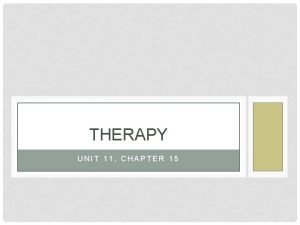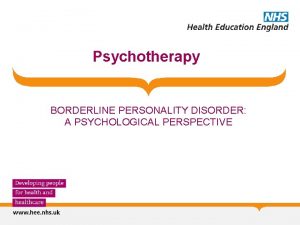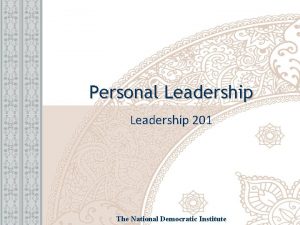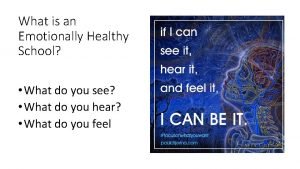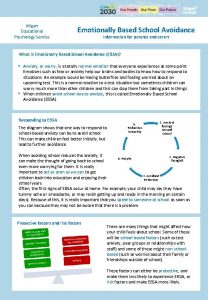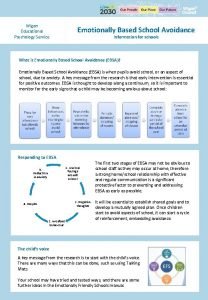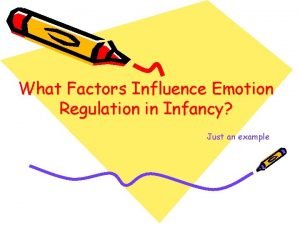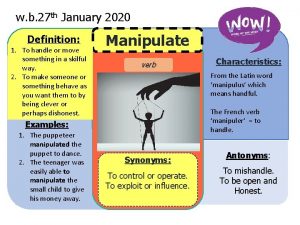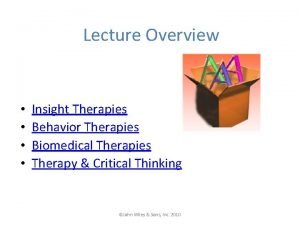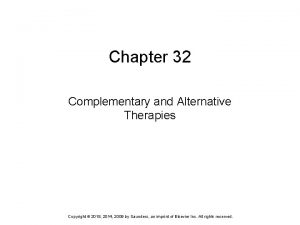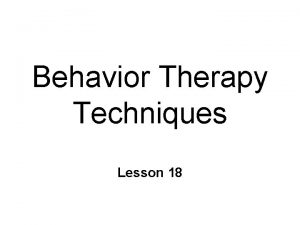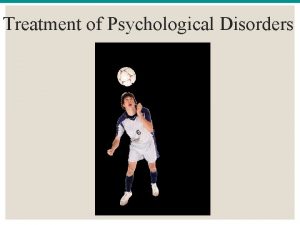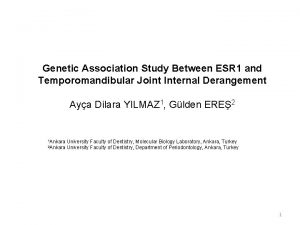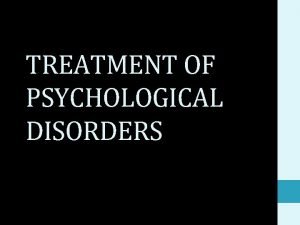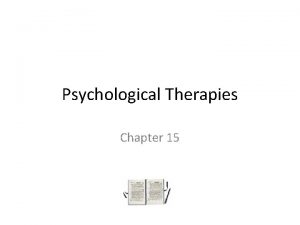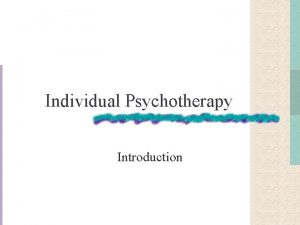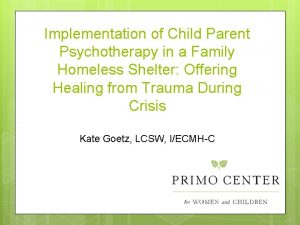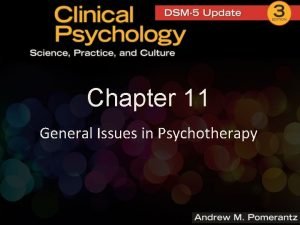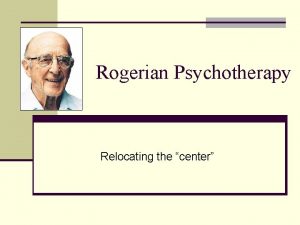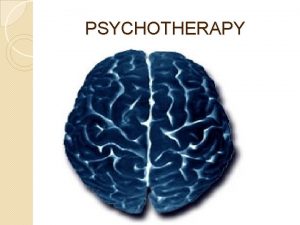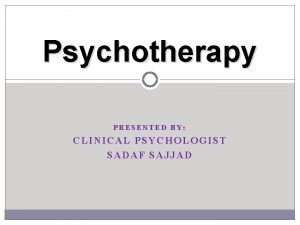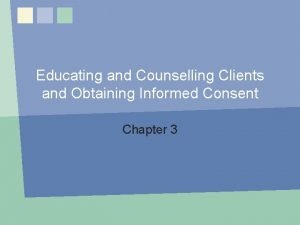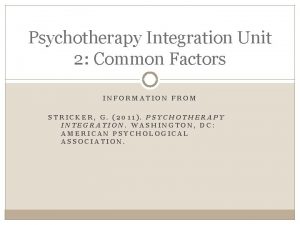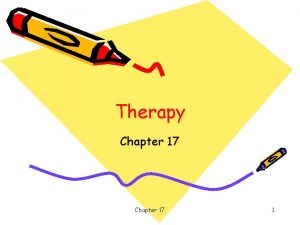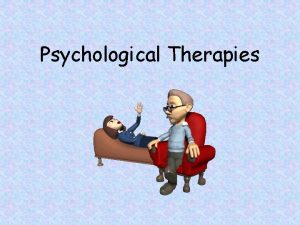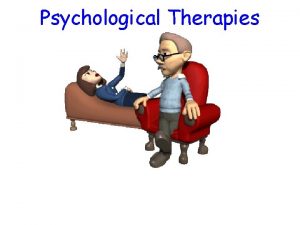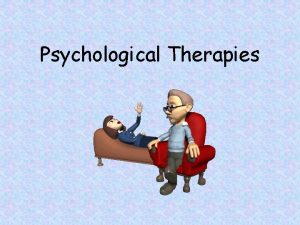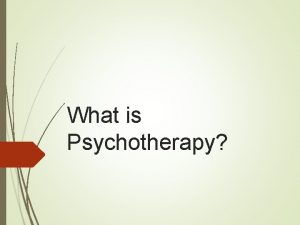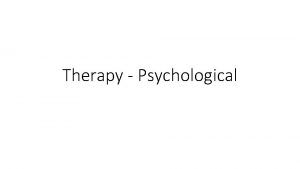Psychological Therapies Introduction Psychotherapy Emotionally charged confiding interaction





















































- Slides: 53

Psychological Therapies

Introduction

Psychotherapy • Emotionally charged, confiding interaction between a trained therapist and someone who suffers from psychological difficulties • There are over 250 different types of therapy.

Four Types of Psychotherapy • Most therapies can be divided into: – Psychoanalytic – Humanistic – Behavioral – Cognitive

Eclectic Approach • Approach to psychotherapy that, depending on the person’s problems, uses techniques from various forms of therapy • Uses whichever therapy works best for the problem the person has

Psychoanalysis

Psychoanalysis • Freud’s theory of personality and therapeutic technique that attributes thoughts and actions to unconscious motives and conflicts

Psychoanalysis Assumptions • Psychological problems are the result of repressed conflicts and impulses from childhood.

Psychoanalysis Assumptions • The therapist must bring the repressed problems into the conscious mind to help patients have an insight about the original cause of the problem.

Psychoanalysis: Psychoanalytic Methods

Free Association • Freudian technique of discovering the unconscious mind--where the patient relaxes and says whatever comes to mind, no matter how trivial or embarrassing

Resistance • In psychoanalysis, the blocking from consciousness of anxiety-laden material

Interpretation • In psychoanalysis, the analyst’s noting of ideas of the meaning behind dreams, resistances, and other significant behaviors to promote insight • The analyst’s ideas of the meaning behind the patient’s dreams, resistance, and other behaviors

Transference • In psychoanalysis, the patient’s transfer of strong emotions linked with other relationships to the analyst • The patient projects feeling from the past to therapist.

Psychoanalysis: The Psychodynamic Perspective

Psychoanalytic Influence • Few therapists follow strict Freudian therapy. • Heavily influenced other types of therapy (interpersonal therapy) • Modern approach is the psychodynamic perspective

Psychodynamic Approach • A more modern view that retains some aspects of Freudian theory but rejects other aspects • Retains the importance of the unconscious mind • Less emphasis on unresolved childhood conflicts

Humanistic Therapies

Nondirective Therapy • Therapist listens without interpreting and does not direct the client (patient) to any particular insight.

Carl Rogers (1902 -1987) • Humanistic psychologist who developed client-centered therapy

Client-Centered Therapy • Humanist therapy, in which therapist uses techniques such as active listening within a genuine, accepting, empathic environment to facilitate the client’s growth. The therapy stresses: – Empathy – Acceptance – Genuineness • Developed by Carl Rogers

Active Listening • Empathic listening in which the listener echoes, restates and clarifies.

Active Listening Characteristics • Active listening entails: – Paraphrasing: uses the words of the client to summarize the conversation – Clarifying: encouraging the client to say more by asking leading questions – Reflecting feelings: mirrors the feelings of the client

Behavior Therapies

Behavior Therapy • Therapy that applies learning principles to the elimination of unwanted behaviors • Uses both classical and operant conditioning • Primary concern is to eliminate the disorder’s behavior, not find the cause of the disorder

Behavior Therapies: Classical Conditioning Techniques

Systematic Desensitization • A type of counterconditioning that associates a pleasant, relaxed state with gradually increasing, anxiety-triggering stimuli • Usually used to treat phobias

Systematic Desensitization Process • Establish a hierarchy of the anxietytriggering stimuli • Learning relaxation methods (progressive relaxation) • Slowly think through the hierarchy, working to relax whenever anxiety is felt

Systematic Desensitization

Systematic Desensitization Variations • Virtual reality- systematic desensitization by way of computerized, anxietytriggering 3 -D stimuli • Combined with models by having the subjects watch someone perform the anxiety-causing behavior

Aversive Conditioning • Type of counterconditioning that associates an unpleasant state (such as nausea) with an unwanted behavior (such as alcohol) • The person is replacing a positive but harmful response with a negative response • Example with alcoholism: Lace a drink with a drug that makes the person becomes sick

Aversive Conditioning

Aversive Conditioning

Aversive Conditioning

Behavior Therapies: Operant Conditioning Techniques

Token Economy • Operant conditioning procedure that attempts to modify behavior by rewarding desired behavior with some small item • The tokens can be exchanged for various privileges or treats • Form of secondary reinforcement

Cognitive Therapies

Cognitive Therapy • Teaches people new, more adaptive ways of thinking and acting • Based on the assumption that thoughts intervene between events and our emotional reactions

Cognitive Therapy • Almost half of all therapist at a university setting use cognitive therapies

Cognitive Therapy

Cognitive Therapy

Cognitive Therapy

Cognitive Therapy

Cognitive Therapy

Cognitive Therapy

Self-Serving Bias • Tendency to judge oneself favorably • Severely depressed patients tend to not have a self-serving bias and tend to blame themselves for problems and credit the environment for successes

Cognitive-Behavior Therapy • Integrated therapy that combines changing self-defeating thinking with changing inappropriate behaviors

Family and Group Therapies

Group Therapy • Having a therapist work with a number of patients at one time • Groups usually consist of 6 to 10 people • Cognitive, behavior, and humanistic therapists all can lead group therapies.

Advantage of Group Therapy • Therapists can help more than one person at a time. • Overall session cost is lower. • Patients interact with others having the same problems as they have. • Builds a sense of community

Family Therapy • Therapy that treats the family as a system • Views the patient’s problems as influenced by or directed at family members • Attempts to guide the family toward positive relationships and improved communication

Types of Therapist

The End
 Example of propaganda
Example of propaganda Emotionally charged words
Emotionally charged words Therapies defined as “talk therapies” include
Therapies defined as “talk therapies” include Trafford psychological therapies
Trafford psychological therapies Trafford psychological therapies
Trafford psychological therapies Trafford psychological therapies
Trafford psychological therapies Trafford psychological therapies
Trafford psychological therapies Introduction to psychotherapy ppt
Introduction to psychotherapy ppt Emotionally unstable personality disorder
Emotionally unstable personality disorder How to take care of yourself emotionally
How to take care of yourself emotionally Evocative responding
Evocative responding Emotionally disturbed
Emotionally disturbed Emotionally healthy schools
Emotionally healthy schools Emotionally unintelligent
Emotionally unintelligent The problem of emotionally unhealthy spirituality
The problem of emotionally unhealthy spirituality Corporate athlete personal development plan
Corporate athlete personal development plan Mentally spiritually physically emotionally
Mentally spiritually physically emotionally Wigan educational psychology service
Wigan educational psychology service Wigan educational psychology service
Wigan educational psychology service Emotionally regulated
Emotionally regulated Manipulative personality
Manipulative personality Module 73 the biomedical therapies
Module 73 the biomedical therapies What is biomedical therapy
What is biomedical therapy Stiriti ayur therapies private limited
Stiriti ayur therapies private limited Westminster talking therapies
Westminster talking therapies Biomedical therapy techniques
Biomedical therapy techniques Advanced therapies apprenticeship community
Advanced therapies apprenticeship community Chapter 32 complementary and alternative therapies
Chapter 32 complementary and alternative therapies Flooding therapy example
Flooding therapy example Psychoanalytic therapy is to as humanistic therapy is to
Psychoanalytic therapy is to as humanistic therapy is to Both psychoanalysis and humanistic therapy stress
Both psychoanalysis and humanistic therapy stress Biomedical therapy definition
Biomedical therapy definition Astellas gene therapies
Astellas gene therapies Pvu
Pvu Bodywork and movement therapies
Bodywork and movement therapies Insight therapies involve verbal interactions
Insight therapies involve verbal interactions Advantages of group therapy
Advantages of group therapy Pharmacological and parenteral therapies
Pharmacological and parenteral therapies Medicine ppt
Medicine ppt Two difference between guidance and counselling
Two difference between guidance and counselling Andrew pethebridge
Andrew pethebridge Commune psychology
Commune psychology Re-educative individual psychotherapy
Re-educative individual psychotherapy Cpp triangle of explanation
Cpp triangle of explanation Bracketing counseling
Bracketing counseling Dodo bird effect definition
Dodo bird effect definition General issues in psychotherapy
General issues in psychotherapy Carl rogers 19 propositions
Carl rogers 19 propositions Psychotherapy refers to
Psychotherapy refers to Psychotherapy definition psychology
Psychotherapy definition psychology Individual psychotherapy definition
Individual psychotherapy definition Quantum psychotherapy
Quantum psychotherapy Imaginal disputation
Imaginal disputation The common factors approach to psychotherapy integration:
The common factors approach to psychotherapy integration:


